There are many interesting aspects of a periodical cicada emergence, including the length of time they spend underground, their massive numbers, their visual appearance, their amazing songs, and the variety of reactions people have to the cicadas. One of most amazing things you can witness during a cicada emergence is to watch cicadas emerge from the earth as nymphs, crawl up a tree, shed their skins, spread their wings and become adults.
Periodical cicadas will typically emerge over a period of several days. If you discover that cicadas have emerged in your yard by finding their skins (exuvia) or adult cicadas, chances are good more cicadas will emerge later that night. Filming a night-time cicada emergence is an excellent opportunity to use your HD Camcorders, Macro camera settings, and other technology you normally don’t get to use.
Here’s a guide to finding cicadas at night and ideas for filming them:
- Be prepared: Get your flashlights ready. Read the manual for your camera to learn about its night time settings, HD settings, Macro settings, etc. Make sure your camera is charged.
- Once the sun sets, head outside with your flashlight and camera. Carefully walk around beneath the branches of trees, shining your flashlight towards the ground. Cicada nymphs live along the entire root system of a tree, so they can emerge 15 or more feet away from the trunk. Watch this video of cicada nymphs to see what to look for. Listen: you can actually hear them walk through the grass and up the bark of a tree.
- Once you’ve spotted nymphs, you can start filming. I usually aim my flashlight at them, and then let the flash in my camera light them up for the photo.
- Once a nymph crawls up the tree, and finds a part of the tree that it likes, it will emerge from its skin and become an adult. The process of completely becoming an adult takes several hours, so this is a good opportunity to make a time-lapse movie.
Here is a series of stills from a movie Roy Troutman made of an eclosing Magicicada:
Step 1: The nymph grabs hold of a leaf
Nymphs will crawl around until they find a place to grab hold of with their tiny tarsal claws. Usually, they find part of a tree branch or leaf. Sometimes they find a car tire, a brick wall or a barbecue.
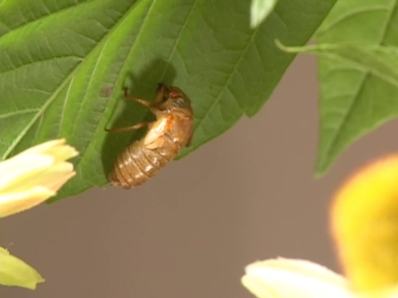
Step 2: The back of the cicada splits open, and the cicada pushes itself out.
The skin of the nymph splits open along the middle of its back, all the way up to its head. The cicada then pushes itself out back-first. You’ll notice that the cicada is white in color with two black spots on its back. At this point the cicada’s body is very soft — until a cicada’s body has hardened, we call them teneral, which means soft or tender in Latin.
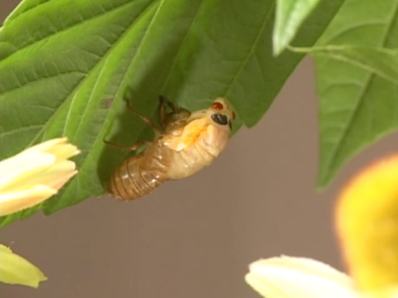
Step 3: With its abdomen anchored in the nymph skin, the cicada curls back, freeing its legs and spiracles.
The spiracles are the holes through which the cicada breathes. You’ll notice fine white strands connected to the nymph skin — those were once connected to the spiracles.
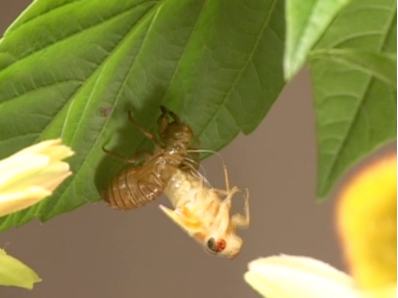
Step 4: The cicada curls forward, grabs hold of its former skin, and frees its abdomen
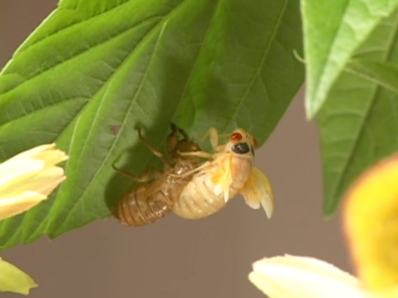
Step 5: The cicada crawls away from its old skin and prepares to inflate its wings
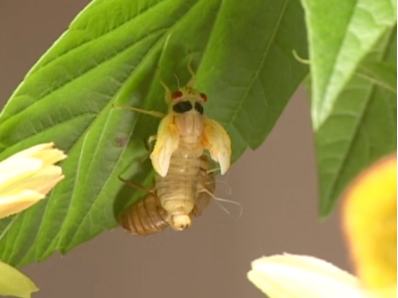
Step 6: The cicadas wings fill with fluid and expand
The cicada inflates its wings using haemolymph, a blood-like fluid also used to transport nutrients in a cicada’s body.
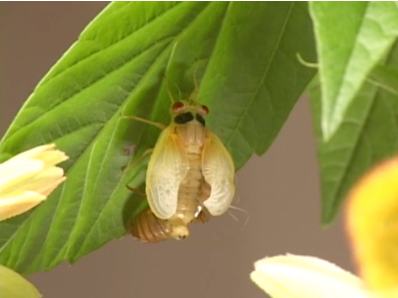
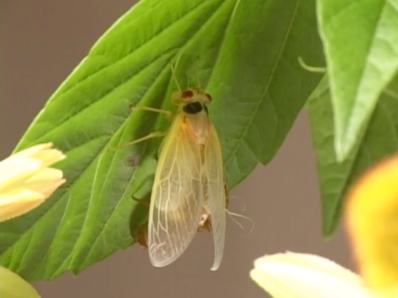
Now, watch the entire video:
Magicicada nymph molting from Roy Troutman on Vimeo.
Step 7: The color of the cicada darkens and its body hardens
Once the cicada has expanded its wings, the cicadas will turn their final color and their bodies and wings will harden. Once the body and wings are sufficiently hardened, they are able to fly and sing.
The “finished product” looks like this:
Magicicada on my finger by Dan from Cicada Mania on Vimeo.
I hope you have the opportunity to watch a nighttime cicada emergence! It can be a lot of fun.
23 replies on “Watch a cicada transform”
What license are the images and videos that appear on this page, and the website? They are excellent! I’m wondering if I can reuse and remix any for educational, non-commercial purposes (CC BY-NC-SA). Thanks!
Most are copyrighted and been licensed.
There’s a lot of CC images On Flickr.
Here are a handful:
I spied the expired shells of three nymphs tonight while at work, around 1am EDT. Saw a freshly-emerged adult and got a good photo of it. Trouble is, my location is not listed at all in your list of years the 17-year cicada would be present in Indiana (I’m in Bloomington) but the photos match your own. Maybe this is a first.
Indianapolos: I’ve got hundreds if not thousands of nymph shells in my back yard and my grill, trees and lamp post are covered in cicadas! I didn’t see that we were on the cycle, either!
I’ve got the EXACT same experience here. According to the chart, this isn’t our year, but I found one yesterday. I’m a bit northeast of Detroit, MI!
A whitish colored one fell out of a tree. It sounded like it was in deep distress. My friend got a couple of photos before her dog was alerted to it from the distress sound and ran over then she ate it. Burlington, Iowa.. Southeast Iowa on the Mississippi River/Illinois border on a cool breezy day.
Hola from Costa Rica, They are out in force and the singing is loud and enjoyable. Have a few shells and will look for their holes. They appear annually not over longer periods and last about 1 1/2 to 2 weeks. Many thanks for your website and complete information. will make my morning hike even more enjoyable.
Muchas gracias. David
Unfortunately, I have a bug phobia; but, I am also in awe of this Metamorphoses as I am in awe of the fragile daffodils that push themselves through the hard ground.
However, I have told my friends if one of these cicadas lands on me, my emails will be coming from the moon.
I enjoyed learning about the BUGS, we have a loud noise, all day long, and can see them up close and personal when they fly into spider webs on our sunroom windows and entertain our cats. At evening time about 7:00 pm they get quiet and stop flying around so we go sit on patio. thanks for all the inf.
How long do they live above ground. And underground do they require any nourishment. Seems a bit unusual 17years underground and such a short life above.
They are singing loudly in WV….
Listening to the sound of them all around me right now. A few fell from the trees onto the street, I moved them back onto the trees so they wouldn’t get hit by any cars. When I was 12 I was scared of the sound of them. I am 46 now,and I now appreciate and love seeing and hearing them. I live in Des Moines, IA and this is such a rare and beautiful treat of nature to get to experience for a second time in my life.
8/27/2023 Burlington,Iowa Southeast Iowa & Illinois border along Mississippi River. Today, a cool breezy afternoon; a whitish one fell from a tree. Unfortunately it was making a loud distress sound unable to fly and it got the attention of my friends dog Nico who then ran up and ate it; as Nico does everything.
They’re singing like crazy in NC!
We loved the video! we learned so much! we can’t wait to see some of them at night.
We would like to use some of your information, with proper credit and links, for our story on http://www.ozarkscreations.com We are a site devoted to the creative endeavors of the Ozarks, with sections not only for the arts, but also for farming and gardening and sustainability.
Proper credits and links?! Wow, most people don’t even give us that. Go for it Jeff!
They are BIG bugs! We think it is cool when they come out of their old skin and the wings get bigger. It was clear and squishy. They get harder before they can fly. We wanted to see them fly and sing an amazing song.
3, 4 and 5 year olds
I live in West Blocton, Alabama and I work for Bibb County E-911. We started receiving calls about strange noises in the rural areas of the county about a week ago. We have now determined, thanks to your website, that the noises people are hearing are the songs of the cicadas. From what I’ve researched I believe they are Magicicada septendecim. My husband and I watched several emerge from the ground three nights ago. It was actually amazing! Today they are flying all around the yard. We are intrigued and trying to learn more about these magnificent insects. Thank you for your videos and other information.
I had the opportunity to see a cicada metamorphsis from the beetle hard shell to the insect itself, all white in color, with orange around the edge of the wings. The wings slowly opened, and it was soo incredible, and then with time turn color. I didnt know it was time for cicada’s this yr., but after talking to several people in other areas of the eastern Atlantic coast, they are in NC and up in PA from what i found out. In watching the video I was able to witness firsthand what the change was and it took about 2 1/2 hours to escape from its shell. Thanks to whoever made that video, because it was indeed very interesting.
Have a Swarm behind my house now!! First Time too.. Not sure how to take them yet. Getting Morning Chorus Right Now
I had never heard of the cicada until recently. We live in Augusta, GA. We noticed a bunch of holes in our yard and then we saw all the empty shells. Had no idea what was going on. Once I found out about the cicada I am now totally infatuated with them. I think they are amazing. There are small woods behind our house and for the past three days they sing all day. I think they are amazing. Love this website with being able to view the transformation.
I know this may sound a little bit crazy but, after watching this video my fear of cicadas has decreased so much… I know we’re about to get some here in Nashville because I’ve already seen a ton of random holes in the ground. I really want to go touch one but I hope they don’t end up flying in my face =P